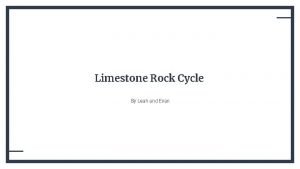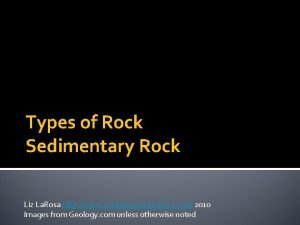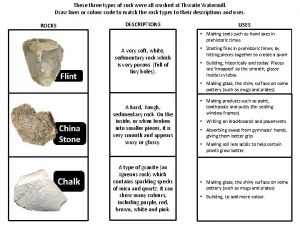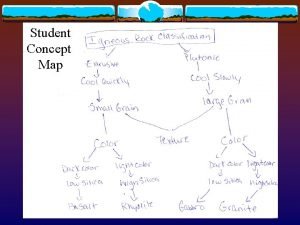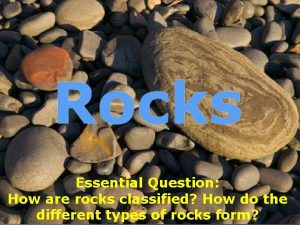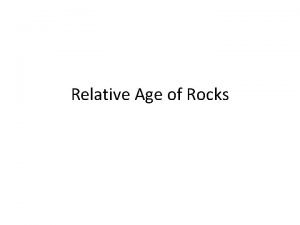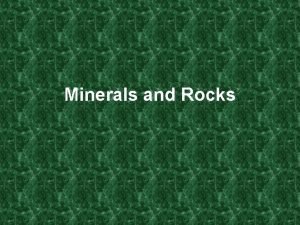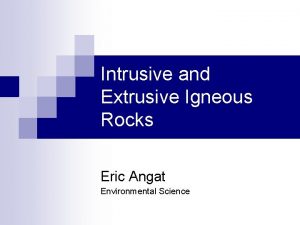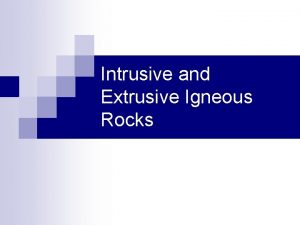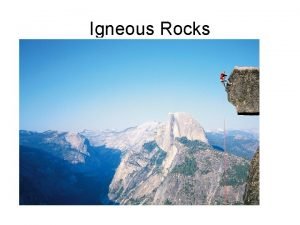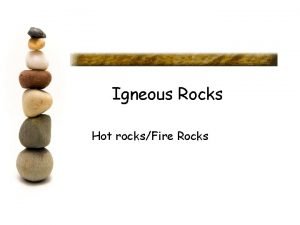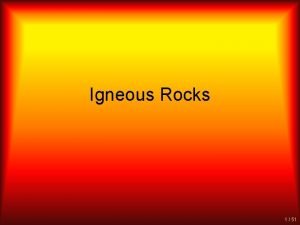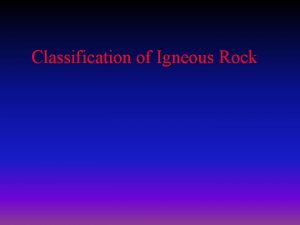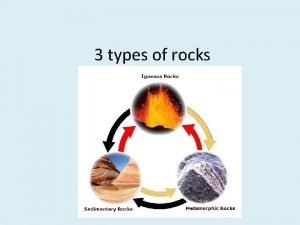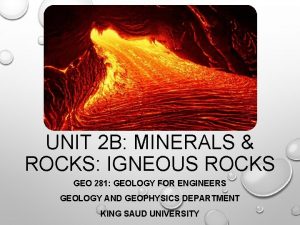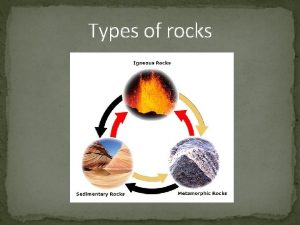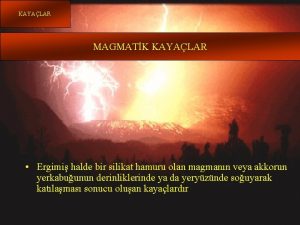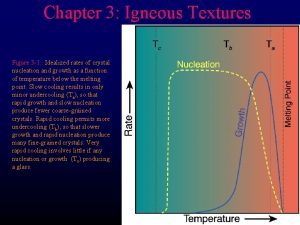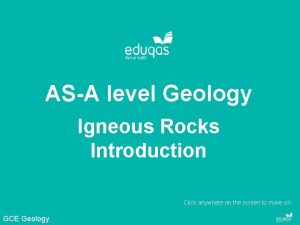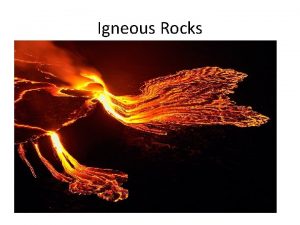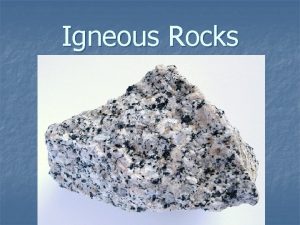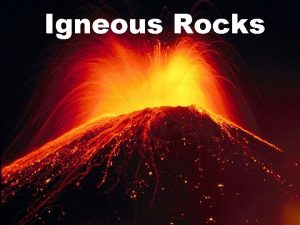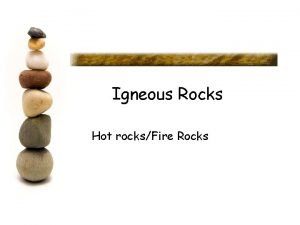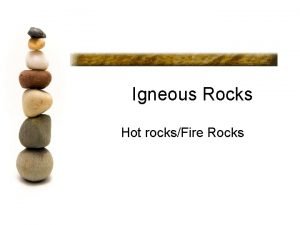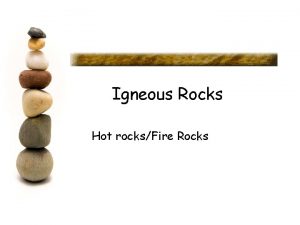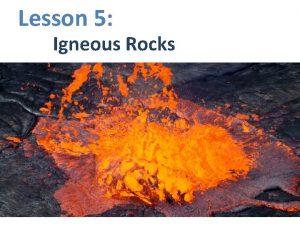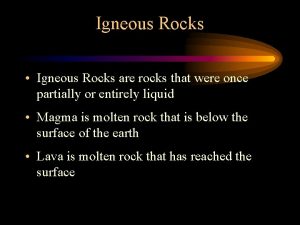ASA level Geology Igneous Rocks Introduction Click anywhere








































- Slides: 40

AS-A level Geology Igneous Rocks Introduction Click anywhere on the screen to move on. GCE Geology

Igneous Rocks GCE Geology

Definition of Igneous Derived from the latin ‘ignis’ meaning fire Formed by the cooling, crystallization and solidification of molten lava or magma Comprise an interlocking mosaic of crystals GCE Geology

Extrusive Igneous Rocks Molten rock reaching the Earth’s surface via volcanoes (lava) is termed extrusive GCE Geology

Intrusive Igneous rocks Molten rock (magma) that solidifies at depth within the lithosphere is intrusive Intrusive rocks may eventually be exposed at the Earth’s surface following a long period of uplift and erosion GCE Geology

Crystal Size and Cooling Rates Crystal size is determined by the rate of cooling of the magma or lava Instantaneous cooling of lava erupted under water as pillow lavas results in a glassy texture, devoid of any crystalline form GCE Geology

Crystal Size and Cooling Rates Rapid cooling in at the Earth’s surface over a few months results in crystals of <1. 0 mm in diameter forming lava flows (volcanic) GCE Geology

Crystal Size and Cooling Rates Minor intrusives-dykes and sills cool slower over thousands of years to form crystals 1. 0 mm-3. 0 mm in diameter GCE Geology

Crystal Size and Cooling Rates Slow cooling in magma chambers deep underground over millions of years results in larger crystals >3. 0 mm in diameter (plutonic) GCE Geology

Crystal Shape 1 - Euhedral Well formed crystals with a regular and recognisable shape. They form when crystals can grow freely in a melt and are not impeded by the presence of any surrounding pre-existing crystals GCE Geology

Euhedral Olivine 3 mm Six-sided shape Olivine basalt from Ubekendt Ejland, West Greenland GCE Geology

Crystal Shape 2 - Subhedral Partially formed crystals with some recognisable shape. They have been partially impeded as they grew by the surrounding preexisting crystals GCE Geology

Subhedral Olivine Some faces flat and planar 1 mm Some faces curved and embayed Picritic basalt, Ubekendt Ejland, West Greenland GCE Geology

Crystal Shape 3 - Anhedral – no regular crystalline shape visible. The shape of the growing crystal is controlled by the arrangement and orientation of the surrounding pre-existing crystals GCE Geology

Anhedral Olivine basalt from Mauritius, Indian Ocean 1 mm Irregular outline with no planar faces evident GCE Geology

Phenocrysts Large well formed crystals in an igneous rock In Shap Granite the pink coloured orthoclase phenocrysts are up to 3 cm in length GCE Geology

Groundmass The remainder of the igneous rock made up of smaller crystals In the case of Shap Granite, the groundmass is mainly crystals of biotite mica and quartz GCE Geology

Phenocrysts and Groundmass Orthoclase phenocrysts up to 6 cm in length Phenocrysts are euhedral and rectangular Implies 2 stage cooling history 1 cm Finer groundmass 0. 51. 0 mm in diameter GCE Geology

Equicrystalline Texture All the crystals in the rock are roughly the same size Produced by a steady or constant cooling rate GCE Geology

Equicrystalline Texture 2 cm Microgranite – even cooling, all crystals 1. 0 – 1. 5 mm GCE Geology

Porphyritic Texture Large crystals (phenocrysts) set in a finer grained groundmass Formed by two-stage cooling GCE Geology

Porphyritic Texture-Giant Feldspar Porphyry Phenocrysts up to 5 cm long Long axes of phenocrysts aligned parallel implies flow of magma Groundmass 1. 0 -1. 5 mm GCE Geology

Vesicular Texture Spherical or ellipsoidal cavities found in lavas As magma moves up towards the surface and the pressure is reduced, gases are exsolved GCE Geology

Vesicular Texture Vesicles represent trapped gas bubbles in this lava flow Vesicles range from 2 mm to 1. 5 cm in diameter Vesicles are stretched and curved indicating flow of the lava Car key for scale GCE Geology

Glassy Texture e. g. in Obsidian No crystals visible due to very rapid cooling 1 cm Shows Conchoidal Fracture like glass GCE Geology

Mineral Content Igneous rocks are classified chemically as Silicic, Intermediate, Mafic or Ultramafic according to the main constituent minerals present and their overall silica content GCE Geology

Silicic Igneous Rocks Quartz, Orthoclase Feldspar, Plagioclase Feldspar, Biotite Mica and Muscovite Mica. Rich in silica >66% GCE Geology

Intermediate Igneous Rocks Up to 10% Quartz, Plagioclase Feldspar, Hornblende, Augite Lower silica content 52%-66% GCE Geology

Mafic Igneous Rocks Plagioclase Feldspar, Augite and Olivine Contain less silica 45%-52% GCE Geology

Ultra-Mafic Igneous Rocks Mainly olivine, small amounts of augite and plagioclase Contain the least silica <45% GCE Geology

The Classification of Igneous Rocks % Silica Content Chemical Group Silicic Over 66% 52% to 66% % Dark Minerals 40% or below % Light Minerals 60% or over Intermediate 40%-70% 30%-60% 45% to 52% Mafic Below 45% GCE Geology Ultramafic 70%- 90% 10%-30% 90% or over 10% or below Rock Names Rhyolite/Obsidian/Pumice (Fine) Micro-granite (Medium) Granite (Coarse) Andesite (Fine) Micro-diorite (Medium) Diorite (Coarse) Basalt (Fine) Dolerite (Medium) Gabbro (Coarse) - Peridotite (Coarse)

Cornish Granite Glassy, colourless quartz 1 cm All crystals over 3. 0 mm in diameter-Plutonic Black biotite mica with pearly lustre Subhedral crystal form White/creamy plagioclase feldspar GCE Geology

Shap Granite Porphyritic texture, large phenocrysts and finer groundmass Finer groundmass of quartz and biotite mica typically 3 mm in diameter Feldspar phenocrysts are euhedral 1 cm Pink-coloured orthoclase feldspar phenocrysts up to 3 cm long GCE Geology

Kaolinised Granite Iron oxide staining due to release of Fe ions from biotite mica Orthoclase feldspar altered to kaolinite by hydrolysis Granite is very crumbly and is described as Growan GCE Geology Biotite mica breaking down to form chlorite Unaltered grey, glassy quartz

Micro-Granite Formed within the crust in a sill or dyke Mineralogy: quartz, feldspar and mica Subhedral crystals Equigranular texture, all crystals 1. 0 – 1. 5 mm in diameter Formed by an even cooling rate over thousands of years GCE Geology 2 cm

Vesicular Rhyolite 1 cm Formed by rapid cooling at the earth’s surface Fine grained < 1 mm, no crystals visible, volcanic Vesicles represent trapped gas bubbles in a lava flow GCE Geology Spherical vesicles up to 3 mm in diameter Mineralogy mainly quartz, feldspar and mica

Gabbro Equicrystalline texture, all crystals roughly similar in size Greenish-black augite Formed deep underground by very slow cooling over millions of years 2 cm Coarse grained, crystals over 3. 0 mm in diameter, suggesting slow cooling GCE Geology Grey/creamy plagioclase feldspar

Porphyritic Dolerite Medium crystal size mainly 1. 0 – 2. 0 mm Mineralogy: plagioclase feldspar, augite and olivine Groundmass constitutes over 75% of the rock Subhedral phenocrysts of plagioclase feldspar up to 3 mm in diameter Two-stage cooling, finally forming an intrusive dyke or sill GCE Geology 1 cm

Basalt 1 cm Chilled margin, very fine grained Formed by rapid almost glassy cooling at the earth’s surface over a few weeks or months Mineralogy: plagioclase feldspar, augite and olivine Crystal size is fine, well under 1. 0 mm, (volcanic) GCE Geology

Peridotite 1 cm Coarse Grained >3. 0 mm Ultra-Mafic Low Silica Content Predominantly Olivine Small Amount of Augite Tiny Amount of Feldspar Mantle Rock GCE Geology
 Sedimentary rock song
Sedimentary rock song Igneous rocks metamorphic rocks and sedimentary rocks
Igneous rocks metamorphic rocks and sedimentary rocks Injustice anywhere is a threat to justice anywhere
Injustice anywhere is a threat to justice anywhere Metaphasepdm
Metaphasepdm Practice click
Practice click Click anywhere to start
Click anywhere to start Click anywhere to start
Click anywhere to start Click anywhere to start
Click anywhere to start Click anywhere to start
Click anywhere to start Click anywhere to start
Click anywhere to start Click clever
Click clever E safety
E safety Click clever click safe
Click clever click safe Click clever click safe
Click clever click safe Https://geology.com/rocks/
Https://geology.com/rocks/ Concept map for igneous rocks
Concept map for igneous rocks Difference between sill and dike
Difference between sill and dike Three types of igneous rocks
Three types of igneous rocks Sedimentary rocks concept map
Sedimentary rocks concept map Intrusive igneous rocks examples
Intrusive igneous rocks examples 3 types of rocks concept map
3 types of rocks concept map Marli miller
Marli miller Luster of igneous rocks
Luster of igneous rocks Intrusive vs extrusive igneous rocks
Intrusive vs extrusive igneous rocks Pumice extrusive or intrusive
Pumice extrusive or intrusive Intrusive vs extrusive igneous rocks
Intrusive vs extrusive igneous rocks Intrusive igneous rocks texture
Intrusive igneous rocks texture What are the physical properties of igneous rocks
What are the physical properties of igneous rocks Intrusive vs extrusive igneous rocks
Intrusive vs extrusive igneous rocks Igneous rock
Igneous rock Elements look like
Elements look like Concept map for igneous rocks
Concept map for igneous rocks Rock
Rock 3 categories of rocks
3 categories of rocks Igneous rock texture
Igneous rock texture How do igneous rocks form
How do igneous rocks form Igneous rocks
Igneous rocks Sedimentary metamorphic and igneous rock cycle
Sedimentary metamorphic and igneous rock cycle Igneous rock
Igneous rock Cumulophyric
Cumulophyric Sedimentary igneous rocks
Sedimentary igneous rocks














